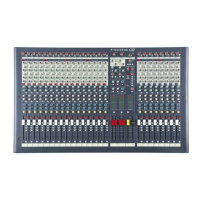1 - 20
MonoInputChannel
1 - MIC INPUT
The mic input accepts XLR-type connectors and is designed to suit a wide range of
BALANCED or UNBALANCED signals. Professional dynamic, condenser or ribbon mics
are best because these will be LOW IMPEDANCE. You can use low-cost HIGH IMPEDANCE
mics, but the level of background noise will be higher. If you press the 48V switch down
the socket provides a suitable powering voltage for professional condenser mics (this is
also known as Phantom Power).
ONLYconnectcondensermicrophoneswiththe
48VpoweringOFF(switchUP),andONLYturnthe
48Vpoweringonoroffwithalloutputfaders
DOWN,topreventdamagetothemixeror
externaldevices.
TAKECAREwhenusingunbalancedsources,
whichmaybedamagedbythephantompower
voltageonpins2&3oftheXLRconnector.
Unplug any mics if you want to use the LINE Input. The input level is set using the GAIN
knob.
2 - 48V (Phantom Power)
Many professional condenser mics need an external powering voltage, normally 48V,
also known as PHANTOM POWER. This is a method of sending a powering voltage down
the same wires as the mic signal. Each switch supplies the 48V power to four MIC inputs.
The adjacent LED illuminates when the power is active.
DONOTUSEunbalancedmicswith48Vswitched
onastheymaybedamagedbythephantom
powervoltage.Balanceddynamicmicsandleads
cannormallybeusedwith48Vswitchedon
(contactyourmicrophonemanufacturerfor
guidance)
Micsshouldalwaysbepluggedin,andalloutput
faderssettominimumbeforeswitching48VONto
avoiddamagetoexternalequipment
3 - LINE INPUT
Accepts 3-pole `A gauge (TRS) jacks. Use this high impedance input for sources other
than mics, such as keyboards, drum machines, synths, tape machines or guitars. The
input is BALANCED for low noise and top quality from professional equipment, but you
can use UNBALANCED sources by wiring up the jacks as shown, although you should
then keep cable lengths as short as possible. Unplug anything in the MIC input if you
want to use this socket. Set the input level using the GAIN knob.

